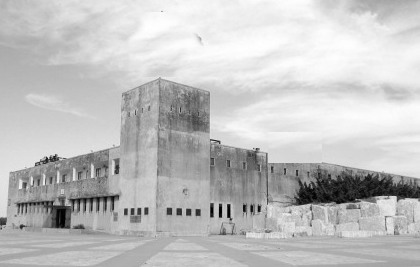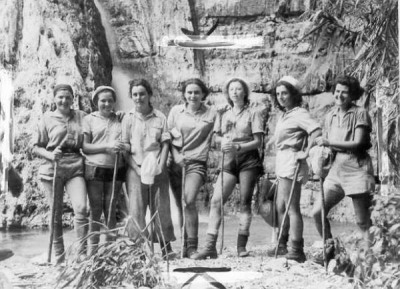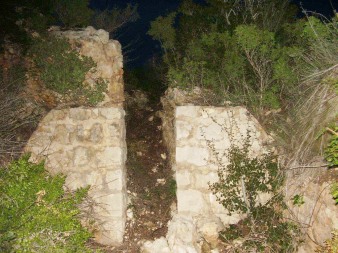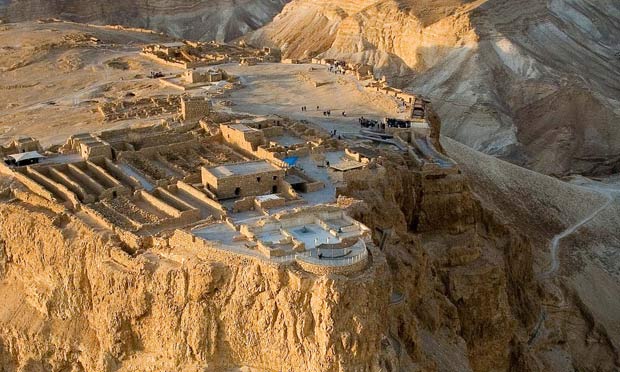Pages in Section 8

OP Final Fortress
ii. After Dunkirk
iii. OP Final Fortress
iv. Police Involvement in Syria and Iraq
v. The Lehi and Avraham Stern
vi. Britain's Break with the Palmach
Palestine prepared itself initially for an attack from the North. OP Final Fortress was an allied plan designed to thwart German invasion.
The pre-war Tegart plan, concocted as a defence against Arab Rebels, was revived
 The border between Syria and Lebanon was already protected by the 1939 fortresses and pillboxes, although the wire fence was gone. Now the emphasis was on back-up protection with fortresses and pill boxes at first in a line across Galilee to Mt Carmel, but as the threat from the south grew stronger the fortifications extended throughout Palestine. The fortresses were officially known as "The Wilson Brown Police Buildings". Wilson Brown, (see Palestine Police at the Start of WW 2) now added to his long requisition lists of building materials all Palestine's cement and other items needed for the reinforced concrete buildings with armoured doors. The photo on the right shows Latrun fortress, one of the wartime tegarts still in use.
The border between Syria and Lebanon was already protected by the 1939 fortresses and pillboxes, although the wire fence was gone. Now the emphasis was on back-up protection with fortresses and pill boxes at first in a line across Galilee to Mt Carmel, but as the threat from the south grew stronger the fortifications extended throughout Palestine. The fortresses were officially known as "The Wilson Brown Police Buildings". Wilson Brown, (see Palestine Police at the Start of WW 2) now added to his long requisition lists of building materials all Palestine's cement and other items needed for the reinforced concrete buildings with armoured doors. The photo on the right shows Latrun fortress, one of the wartime tegarts still in use.
Once built, Police, the British Section of which became members of the armed forces in 1942, filled the forts. The largest housed one hundred police and was equipped with sufficient food, overhead water tanks and underground cisterns to withstand a three month siege.
Rumour has it that one other structure was included in the list of obvious fortresses, a large military hospital in the hill country of Northern Palestine built over a complex of underground tunnels and rooms that, during WW 2, contained not only the HQ of a resistance organization but also laboratories where Jewish, French and British scientists undertook nuclear research in support of the atom bombs the allies built to defeat the Japanese. In all fairness it should be said that an Israeli minister had the rumour looked into and announced there was no truth in it but as a former queen of Tel Aviv night life, Mandy Rice Davies once said on another occasion, "he would say that, wouldn't he?"
 As part of OP Final Fortress the government allowed the British Army, in collaboration with the Jewish Agency, to train an elite Jewish force of guerrillas, both male and female, to resist the Germans. This Force came to be known as the Palmach. The British officially allowed no more than 100 Palmach to bear arms within Palestine but the army recruited far more than 100, many of them members of the Notrim who were already legally allowed to bear arms, although only the shot guns supplied by the police. These were useless for guerilla work so Notrim members of Palmach used their own more efficient but illegal weapons in training and, in doing so, revealed them to British officials.
As part of OP Final Fortress the government allowed the British Army, in collaboration with the Jewish Agency, to train an elite Jewish force of guerrillas, both male and female, to resist the Germans. This Force came to be known as the Palmach. The British officially allowed no more than 100 Palmach to bear arms within Palestine but the army recruited far more than 100, many of them members of the Notrim who were already legally allowed to bear arms, although only the shot guns supplied by the police. These were useless for guerilla work so Notrim members of Palmach used their own more efficient but illegal weapons in training and, in doing so, revealed them to British officials.
British officers from the Signals also trained Haganah members many of whom were women to form a radio network and to act as spy cells in the event of a German invasion. What isn't generally known is that the radio network was not only to be used for communications but was intended to anticipate modern drones. I know this because my father, a telephone communications engineer, built wires up the side of the watchtower,a feature of the house we lived in on Mt Carmel, and then retreated to the cellars where he kept a special radio set. Using this set he controlled a homemade flying toy plane to fly over our verandah where we ate most of our meals in summer. This caused a huge row between my parents because the toy plane dropped stones onto our dining table and broke a teacup, part of a valued wedding present.
 Haifa, as a strategic area, was an important part of OP Final Fortress. Yitzhak Sadeh, the leader of the Palmach, devised Plan North, which was approved by the Special Operations Executive in Cairo. Plan North included a special enclave built in the Carmel Range known as the Carmel Plan, a location from which the Palmach and other Jewish volunteers could defend North Palestine and attack Nazi communications and supply lines. Yitzhak Sadeh also envisaged it as the last stand by the total Jewish population of Palestine should the Germans succeed in conquering Palestine.
Haifa, as a strategic area, was an important part of OP Final Fortress. Yitzhak Sadeh, the leader of the Palmach, devised Plan North, which was approved by the Special Operations Executive in Cairo. Plan North included a special enclave built in the Carmel Range known as the Carmel Plan, a location from which the Palmach and other Jewish volunteers could defend North Palestine and attack Nazi communications and supply lines. Yitzhak Sadeh also envisaged it as the last stand by the total Jewish population of Palestine should the Germans succeed in conquering Palestine.
(The photo on the left shows a bunker on Mt Carmel, part of the Carmel Plan excavated by one of our Israeli advisers, Michael Gottschalk, whose father, a Haifa lawyer, was involved in digging the trenches.)
 Hardly surprisingly many Jews equated the Carmel Plan as the 20th Century equivalent of Masada.
Hardly surprisingly many Jews equated the Carmel Plan as the 20th Century equivalent of Masada.
(The photo on the left shows Masada.) Masada is a Roman fort built on a steep hill near the Dead Sea. It was captured from the Romans by a band of Jewish rebels in CE 63. Jewish refugees who had fled from Jerusalem held Masada against the Romans for a further three years. Just before the Romans took back the fort, the entire Jewish population committed suicide.
Because of this ancient event, some Jews called the Carmel Plan 'The Final Fortress', whereas, for the British, 'OP Final Fortress' was the name given to the defence of the whole of Palestine and included the tegarts, dugouts in Safad and other areas as well as Mt Carmel